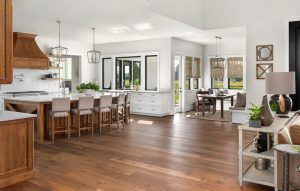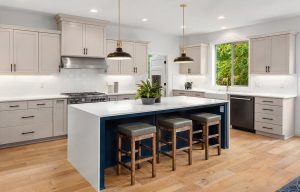When it comes to choosing the right flooring for your kitchen, hardwood floors often stand out as a top contender. Their natural beauty and timeless appeal make them a favourite among homeowners who want to add a touch of elegance to their space. Unlike colder materials like tile or stone, hardwood floors in kitchen areas offer a warm and inviting atmosphere that makes spending time there more enjoyable. Plus, they can significantly boost your home’s value, which is always a nice bonus if you’re thinking about selling in the future.
Why Hardwood Floors are a Timeless Choice for Your Kitchen
When it comes to selecting the perfect kitchen flooring, hardwood floors offer timeless beauty and practicality. Their natural charm enhances your space, while also increasing your home’s value.
- Timeless Elegance: Hardwood floors give your kitchen a lasting, classic beauty.
- Boosts Home Value: Homes with hardwood floors often sell for more, making them a smart investment.
- Warm and Inviting: Unlike cold tiles, hardwood adds warmth and comfort to your kitchen.
- Versatile Design: Hardwood fits many styles, from traditional to modern, and offers various finishes.
- Durability with Character: Well-maintained hardwood floors can last for years, gaining unique character over time.
- Managing Risks: Spills and scratches can be prevented by cleaning promptly and using protective mats.
- Selecting the Right Wood: Opt for hardwoods with high Janka ratings, like hickory or maple, for durability.
- Solid vs. Engineered Hardwood: Engineered hardwood resists moisture better, while solid can be refinished multiple times.
- Regular Maintenance Tips: Vacuum often, use damp mops, and place rugs in high-risk areas to preserve the floors.
- Waterproof Options Available: Consider waterproof wood flooring for extra protection against moisture.
Why Choose Hardwood Floors for Your Kitchen?
Picking hardwood floors for your kitchen can transform its look and use. Hardwood floors have a natural beauty that never goes out of style making them a top pick for homeowners who want to boost their kitchen’s look. Unlike tile or stone floors, hardwood creates a warm and welcoming feel that’s easy on your feet and eyes. This warmth doesn’t just make your kitchen a nicer place to hang out; it also adds a lot of value to your home. This can matter a lot if you ever plan to sell. The appeal of hardwood lies in its ability to blend style with comfort offering a surface that’s both practical and pretty.
What’s more, hardwood floors have a versatility that allows them to fit in with different kitchen designs, whether you prefer traditional or modern styles. They come in a variety of finishes and wood types that can match any style you like. Here are some advantages of picking hardwood floors for your kitchen:
- Timeless Beauty: Hardwood floors stay in fashion making sure your kitchen looks stylish for a long time.
- Increased Home Value: Homes with hardwood floors in kitchen often sell for more.
- Comfort and Warmth: Unlike cold tiles, hardwood feels cozy under your feet.
Hardwood’s appeal comes from how it gets better with age gaining character as time passes while staying strong at its core. This toughness means that if you take good care of it, your kitchen floor can stick around for many years giving you both good looks and usefulness all in one.
Understanding the Risks: Spills, Scratches, and Water Damage
When you think about putting hardwood floors in your kitchen, you need to know about the risks. Kitchens see a lot of foot traffic, spills, scratches, and water. These things can make it hard to keep hardwood floors looking good. Spills from cooking or doing dishes can soak into the wood causing water damage or stains if you don’t clean them up fast. Also, chairs moving around and people walking can scratch and dent the floor.
To lower these risks and keep your hardwood floors looking nice and lasting long, you have to take care of them . Here are some useful tips to help you look after your kitchen floors:
- Clean Spills Right Away: Clean up any spills as soon as they occur to stop moisture from soaking into the wood.
- Put Down Protective Mats: Set rugs or mats in spots with high risk like near the sink or stove to guard against water splashes and scratches.
- Clean Often: Sweep or vacuum to get rid of dirt and bits that might scratch the surface.
- Stay Away from Strong Cleaners: Use mild cleaning products made just for hardwood floors to keep their finish intact.
If you stick to these tips, you can enjoy the lasting charm of hardwood floors in your kitchen while cutting down on possible damage. Keep in mind, a bit of care goes far in keeping the beauty and use of your floor choice intact.
Picking the Best Wood Type for Long-lasting Floors
When you’re choosing the best wood type for your kitchen floors, you need to know about the Janka rating. This rating tells you how hard the wood is, which affects how long it lasts and how well it works in busy areas like kitchens. Harder woods don’t scratch or dent as so they’re great for places where things might spill and lots of people walk. Take hickory, for example. It has a Janka rating of 1820, which makes it one of the toughest local woods you can get. Maple is another good choice, with a rating of 1450. It stands up well to everyday use and abuse.
Picking a wood type with a high Janka score helps your kitchen floors handle daily wear and tear. Check out these top picks:
- Hickory: This wood stands out for its toughness and striking grain designs.
- Maple: It has a smooth feel and light shade that adds brightness to kitchens.
- White Oak: With a Janka score of 1360, it strikes a good balance between toughness and looks.
When you go for these tougher wood types, you’re not just making your kitchen floors last longer – you’re keeping them looking good too. Keep in mind, spending more on quality materials pays off in how well they work and how great they look.
Solid vs. Engineered Hardwood: Which is Better?
When choosing between solid hardwood and engineered hardwood for your kitchen, you need to know how they differ in structure and how they work. Solid hardwood is one piece of wood giving a traditional look and allowing you to sand and refinish it many times. But water can damage it more , which might worry you in kitchens where things often spill. Engineered hardwood though, has a real wood layer on top of plywood layers. This makes it more stable and better at handling moisture so it works well in places where humidity changes a lot.
When it comes to water resistance engineered hardwood beats solid hardwood because of its layered structure that limits swelling and shrinking. This makes it a great pick for kitchens where water is bound to spill. While solid hardwood looks timeless and can stick around for years if you take care of it engineered options are tougher without looking any less pretty. If you’re trying to decide between these two types of flooring for your kitchen, think about these things:
- Water Resistance: Engineered hardwood handles moisture better.
- Durability: You can sand and refinish solid hardwood many times, which helps it last longer.
- Looks: Both types look great but have different textures and grain patterns.
Your decision will come down to what matters most to you: upkeep, looks, and how wet your kitchen might get.
Keeping Your Kitchen’s Hardwood Floors in Good Shape
Taking care of your hardwood floors in kitchen is key to keep them looking good and lasting long. You need to clean them often to make sure they stay in top shape. Begin by using a vacuum or dry mop to get rid of dust and bits that might scratch the floor. To clean more , use a wet mop, but make sure it’s not too wet. Keep in mind that water can harm hardwood so clean up spills right away to stop stains or warping. Think about putting rubber mats in spots where splashes happen a lot, like near the sink, to give your floor extra protection.
In busy areas like entryways or around kitchen islands, rugs or mats can help cut down on wear and tear. Choose rugs with non-slip backings to avoid accidents and make sure they’re easy to clean. Here’s a quick list to keep your hardwood floors in kitchen in good shape:
- Vacuum often to get rid of dirt and grit.
- Use damp mops and wring them out well.
- Clean up spills right away to stop damage.
- Put rugs or mats in areas at high risk.
If you stick to these basic steps, you’ll be able to enjoy your classic hardwood floors while cutting down on possible damage from everyday kitchen use.
Exploring Waterproof Wood Flooring Options
When you’re looking at floor choices for your kitchen waterproof wood flooring stands out from the crowd. This new approach mixes the classic look of regular hardwood with better protection against moisture, which works great in busy kitchens. Unlike normal wood floors that can get damaged by water waterproof wood flooring can handle spills and splashes without losing its good looks. This means you can have the cozy and classy feel of wood in your kitchen without always worrying about water getting on it.
Waterproof wood flooring has a lot going for it making it a good pick for homeowners:
- Tougher Floors: Treatments boost the Janka rating making these floors better at handling everyday use and damage.
- Water Protection: Special coatings shield the top of the floor from moisture, keeping your hardwood floors in kitchen in great shape even when spills happen.
- Aesthetic Versatility: Available in various finishes and styles, waterproof wood flooring can complement any kitchen design while maintaining its natural charm.
This type of flooring not only enhances the functionality of your kitchen but also adds value to your home by offering a long-lasting and stylish solution. Whether you’re renovating or building anew, waterproof wood flooring is worth considering for its blend of practicality and beauty.
Summary
Choosing hardwood floors for your kitchen can significantly enhance both the look and functionality of the space. The natural elegance of hardwood adds a timeless charm that many homeowners find appealing. Unlike tile or stone, hardwood offers a warm and inviting atmosphere, making your kitchen a more pleasant place to spend time. This warmth not only improves your daily experience but also boosts the value of your home, which is beneficial if you ever decide to sell. Hardwood’s versatility allows it to blend seamlessly with various kitchen designs, from traditional to modern, offering a range of finishes and wood species to match any style preference.


